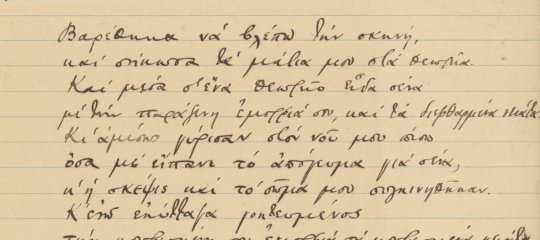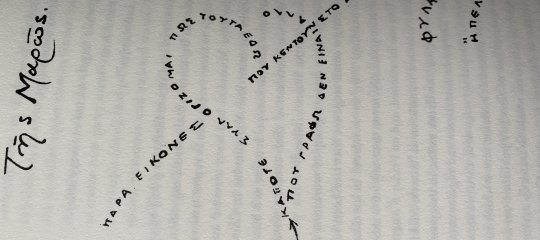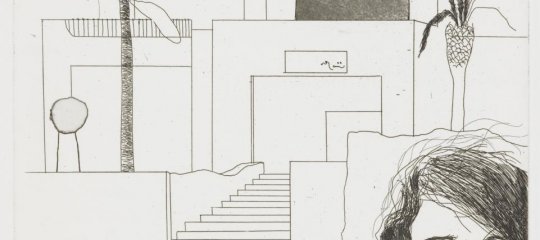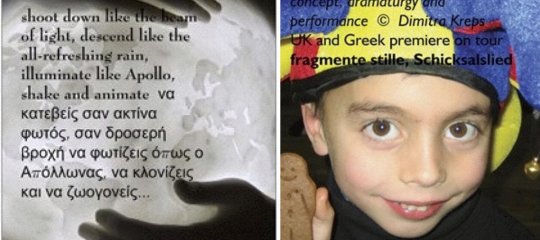Ο δραματικός μονόλογος στην ποίηση των Καβάφη, Ρίτσου και Browning.
tzanidaki writes, "Εργασία 3ετους φοιτήτριας του τμήματος Κλασσικών Σπουδών του παν/μιου του Reading
Δήμητρα Τζανιδάκη
"
18 Νοεμβρίου 2005
Dramatic Monologue in the Poetry of Cavafy, Ritsos and Browning. A Comparative Study.
It is the purpose of this study to examine and compare the style and techniques used by Victorian poet Robert Browning and Greek poets Cavafy and Ritsos in their use of dramatic monologue. This is achieved by firstly analysing the poems ‘Porphyrias’s Lover’ (Robert Browning), ‘My Last Duchess’ (Browning) ‘Kaisarion’ (Cavafy)and ‘Moonlight Sonata’ (Ritsos) for their similarities and differences in style, and secondly examining ‘The God Abandons Anthony’, ‘Alexandrian Kings’ (Cavafy) and ‘The Bishop orders his tomb at St Praxed’s Church’ ‘Fra Lippo Lippi’ (Browning) for their historical use of setting, topic or subject. These poems have been selected because they are clear examples of each poets work that demonstrate the dramatic monologue technique, and although it would be possible to concentrate on a comparison between the poetry of Robert Browning and Yannis Ritsos who are both renown for their dramatic monologues, Cavafy is also included because he offers a different perspective to a historical and to a lesser extent, a philosophical insight to the genre.
Each poem depicts the key characteristics of dramatic monologue, which are first person narration, drama and the inclusion of a third person audience or auditor, a trait which Cavafy explores rather uniquely in his poem ‘Kaisarion’ where the auditor is not a physical presence.
‘Porphyria’s Lover’ is arguably the first dramatic monologue in the English language and predates both Cavafy and Ritsos in the Greek language. It is the most dramatic in both style and language. The language is descriptive and plays on child like speech with fatal undertones. The style is progressive and the murder is reached as a dramatic climax. It is also macabre and displays traits of the grotesque.
The language in ‘My Last Duchess’ is calm. It is a drawn out, one sided conversational boast yet the Duke’s speech is sophisticated and eloquent.
The style contains a gradual build up to the whole story, and the drama takes place slowly with obvious mystery surrounding the fate of the Duchess. The language and actions of the Duke relay his jealous and controlling nature and yet his mannerisms and speech make him affable and admirable to such an extent the reader refrains from casting a moral judgement on him. In both poems Browning demonstrates the ability to detach himself completely and in the former, even offers the insight to a killers psyche using the monologue narrative.
‘The Moonlight Sonata’ displays melancholy and anguish with an underlying tone containing subtle eroticism. This is created in the increasing tension between the speaker and her audience, as her pleads become more provocative her companion retreats further away, also emphasising the sense of loss in the poem.
The style is theatrical and the imagery is symbolic. The poem is relatively long yet Ritsos maintains all the emotion throughout. Ritsos uses elaborate symbolism in way not found in either Cavafy or Browning such as the broken chair and piano. The she – bear too represents the woman who is equally as aware of her lonely existence and seeks to escape it. Even the dilapidated house is reminiscent of the dissolution of the middle class, a personal trait familiar to Ritsos himself. Furthermore he was a Marxist and the house also mirrors the withering away of the bourgeoisie.
The decay and dilapidation also serve the purpose of illustrating the woman’s soul and heart. Her heart, comparable to that of the youth who remains out of her grasp, is trapped inside her frail and aging body creating a psychological claustrophobia.
Cavafy’s style is also theatrical, whilst demonstrating (homo) eroticism and elements of the dream-like. The language used in ‘Kaisarion’ progresses from a dispassionate, formal mode to an altogether softer method which creates fresh warm tones. The poem opens with the speaker retelling the events of the previous evening, the discovery of Kaisarion is built up gradually in a step by step process. Upon discovery, Kaisarion is revived from historical limbo and his famous parents, Cleopatra and Julius Caesar are snubbed in favour of the forgotten prince’s obscurity. The poem is theatrical in way similar to Ritsos, an example of this is the bedside light going out. The reader may imagine the contorting shapes and twisting shadows as this occurs.
In terms of how each poet uses the element of history, Cavafy revives the memory of history’s losers and reinterprets events from a poetic perspective. ‘Alexandrian Kings’ is a theatrical uplifting illustration of the futile coronation. The language is informative to intensify the pseudo historical element to the poem. The drama takes place on the stage and is described as theatre by the crowd, the first person narration allows the speaker to relay the events as if present and captures the positive atmosphere in doing so. The people are aware that it is all just theatre but are resigned to enjoy the coronation of Kaisarion and his brothers despite in the impending fall of Egypt to the Roman Empire.
In contrast, ‘The God abandons Anthony’ is more melancholic. The loss of Alexandria is felt by the auditor and speaker who is in many places Cavafy himself. The monologue style allows a first hand account to each of the poems addressed, but in this poem in particular the poet is speaking through history directly to Mark Anthony on the eve of his decline. The action comes from the movement of the auditor who for example, moves to the window. It is also the auditor who must leave Alexandria and again creates action in the poem. The subtlety in this poem contrasts with the dramatic action in ‘Porphyria’s Lover’, which causes temporary horror for the reader, and the theatrical elements in ‘Alexandrian Kings’
Geographically Alexandria was Cavafy’s native city where he spent most of his life. To a certain extent the personal feelings of the poet are not only the inspiration for this poem, but the driving force behind it. The poem marks the end of the Ptolemy’s reign and although it is not mentioned directly, the beginnings of Roman rule.
Cavafy introduces a philosophical element into the monologue with the use of this title, but more than question the apparent abandonment of Anthony by God, it serves the purpose of stressing the speaker’s sense of absolute loss.
Browning explores history with a mixture of fantasy and realism. ‘Fra Lippo Lippi’ depicts the attitude of one fictitious painter during the early age of the Renaissance. It portrays a conflict between the early stages of the renaissance era and tradition at the same time being a humorous and subtly satirical representation of the church.
‘The Bishop Orders His Tomb at St Praxed’s Church’ demonstrates a determined and extravagant one sided conversation, through which the luxurious imagery reveals the spirit of the renaissance and the recovered zest for Greco-Roman arts. Both poems depict a subtly satirical attack on the Church. In these poems Browning shows his ability to detach from reality and with imagination, explore an era which was obviously appealing to him.
Through the examination of style, content and use of history to poetic result, this study has drawn out the differences and similarities between the Greek poets and Victorian poet. For a future study it may be interesting to examine the origin of dramatic monologue and to trace it through history from Theocritus in the 3rd century B.C, to the poets addressed in this study. It would be interesting to determine where Browning, Ritsos and Cavafy appear in the historical timeline of dramatic monologue. However, all three poets through their differences are equally effective in their works and realisation of dramatic monologues.
- Εισέλθετε στο σύστημα για να υποβάλετε σχόλια










